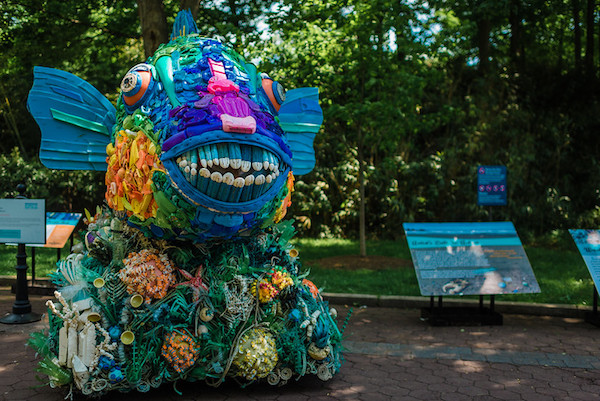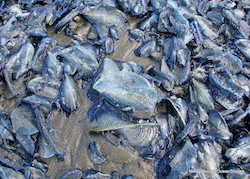SEJournal Online is the digital news magazine of the Society of Environmental Journalists. Learn more about SEJournal Online, including submission, subscription and advertising information.
 |
| A sculpture made entirely of plastic debris collected from beaches. Volunteers with the Smithsonian's National Zoo’s 2016 Washed Ashore Project processed an estimated 18 tons of garbage collected from more than 300 miles of coastline to create 68 sculptures of marine animals. Photo: Adam Mason, Smithsonian's National Zoo, via Flickr Creative Commons (CC BY-NC-ND 2.0). |
Perspective: On the Persistence of Ocean Plastics
By Juli Berwald
Twenty years ago, U.S. News and World Report published the first story I’d ever read about the trashing of the Pacific Ocean. It described how, on a return trip from Hawaii to Los Angeles, Captain Charles Moore, an ocean enthusiast and amateur scientist, had discovered armadas of garbage riding the waves, including a 10-mile-wide flotilla of disposable plastic take-out sacks, “an estimated 6 million of them destined for Taco Bells around the country.”
A few years earlier, when I was a graduate student studying phytoplankton 500 miles off the coast of Iceland, I had seen a seabird with a six-pack ring around its legs. So when I read that U.S. News article, I thought to myself, I bet the ocean plastic problem isn’t constrained to the Pacific.
Today, we know it isn’t.
Plastic-laden gyres spin through all six of our great ocean basins. Between eight million and 11 million tons of plastic pour into our oceans each year, a garbage truck full every minute. That tallies to 200 million tons now adrift in our seas.
Plastic unicorns, recycling myths
Where might the ocean plastics story be headed?
One place to start is the work that the nonprofit environmental advocacy group Ocean Conservancy has done on this issue under the guidance of materials scientist Anja Brandon. Anyone looking for background into the science of plastic should take a look at a set of excellent factsheets put out by Brandon and Ocean Conservancy, one of which focuses on plastic composition and biodegradability and the other on recycling.
But as reporters work the issue, a couple of highlights stand out.
First, although it sounds like an oxymoron, sustainable plastic does exist. It’s both made from plants and biodegradable.
But these plastic unicorns only account for a few percent of what is currently produced. The other more problematic permutations make up the bulk of production: plastics that are made from plants and that are not biodegradable; plastics that are biodegradable but are made from fossil fuels; and plastics that are made from fossil fuels and that are not biodegradable.
Second, as long feared, the efficacy of the chasing arrows symbol is largely a myth. Estimates are that only 9% of plastic produced has been recycled.
Combatting plastic colonialism
Other disinformation swirls around this issue.
In 2015, a study in Science suggested that the largest contributor to ocean plastic was Southeast Asia. Since then, though, there’s been a sobering recognition that much of that plastic starts in the United States and is then shipped overseas in what is now called plastic colonialism. A 2021 federal report revealed that the United States is the world’s largest producer of plastic.
With the recognition of our home-grown complicity in mind, Ocean Conservancy’s Brandon suggests reporters stay tuned to happenings in California, where the organization’s 30-year database of Beach Cleanup data was used as evidence to drive new regulations.
The new rules emerged this past June, when California passed a sweeping law, SB 54, limiting single-use plastics by a quarter and requiring all packaging to be recyclable or compostable by 2032.
A global treaty on plastics
On an international level, this year the first international treaty on plastics was negotiated among 175 countries. The treaty is similar to the Paris Climate Agreement in that it allows each country to develop its own goals. A legally binding agreement is expected by 2024.
A growing industry of plastic offsetters gives
companies the chance to be ‘plastic neutral’
by offering plastic credits a la carbon credits.
Meanwhile, a growing industry of plastic offsetters gives companies the chance to be “plastic neutral” by offering plastic credits a la carbon credits. Skeptics warn this could become a new form of greenwashing.
And problems loom at the intersection of climate change and plastics.
Currently, plastic production accounts for between 4% and 8% of oil consumption annually. As fossil fuel companies become pressured to turn away from energy production, plastic production is Plan B. By 2050, plastic is expected to expand to 20% of global oil use.
A $9.4 billion new plastic production compound under construction by Formosa Plastics in Louisiana portends this growth.
Nurdles and neuston
Formosa Plastics is part of another chapter in this story. In 2019, the firm was ordered to pay $50 million for polluting the Gulf of Mexico with nurdles. These are pre-production lentil-sized pieces of plastic, which marine animals mistake for fish eggs.
To survey Gulf of Mexico beaches for nurdles, some of the funds from the firm’s fine were awarded to Jace Tunnell, director of the Mission-Aransas National Estuarine Research Reserve at the University of Texas Marine Science Institute. Tunnell’s Nurdle Patrol, which relies on citizen scientists, has already collected more than 2.1 million nurdles along coasts from Brownsville to Boca Raton.
Farther out at sea, plastic continues to become more entangled with marine life. This past spring, ocean scientist Rebecca Helm and colleagues reported initial findings from what they refer to as the Vortex Swim.
In this community science survey, French long-distance swimmer Benoît Lecomte stroked through roughly the same patch of the Pacific Ocean that Moore sailed more than two decades ago, collecting samples along the way.
The big takeaway was that the floating plastic garbage was full of life.
The samples revealed a correlation:
the more plastic, the more marine life,
in particular marine surface-dwelling organisms.
What’s more, the samples revealed a correlation: The more plastic, the more marine life — in particular, marine surface-dwelling organisms also known as obligate neuston.
Neuston are part of a poorly studied but vibrant ecosystem that includes animals worth Googling for their stunning looks (you can see examples here): Janthina sp., a violet snail that lives upside down on a raft of gooey bubbles; the azure- and white-striped sea dragon Glaucus sp. and three sapphire species of colonial jellyfish or siphonophores — the Portuguese man o’war Physalia sp., the blue button Porpita sp. and the by-the-wind sailor Velella sp.
Stopping the scourge at the source
 |
| By-the-wind sailors — marine surface-dwelling jellyfish in the genus Velella — washed up on the shore in Washington State. Photo: MÏk, via Flickr Creative Commons (CC BY-NC-SA 2.0). |
The presence of neuston alongside the plastic suggests that efforts to indiscriminately scoop plastic from the sea surface, long proposed by projects like The Ocean Cleanup, may be both unfeasible and disruptive to seas where neuston float in high abundance.
In September, researchers from the Ocean Cleanup published new findings about the composition of the garbage patch itself. An analysis of a 2019 haul revealed that more than three-quarters of the mass collected was lost fishing gear.
Untold tons of abandoned nets ensnare hundreds of thousands of fish and marine mammals each year. Cleanup efforts focusing on these ghost nets — using drones and satellites to zero in on plastic fishing gear — may provide more targeted and effective methods for removing particularly deadly plastic waste.
Looking back at the 2002 U.S. News article about ocean plastic, I’m struck now by how much remains the same, aside from the “just discovered” angle.
Fishing lines, nurdles, slicks of trash continue to ride the waves of the open seas. But perhaps what has begun to change is the recognition that the ocean plastics story is really a land story.
As Monica Medina, assistant secretary of state for oceans and international environmental and scientific affairs, told a group of reporters at the Society of Environmental Journalists’ annual conference last spring in Houson: “Plastic is a scourge that reaches from the tallest mountaintops to the deepest depths of the ocean floor. We need to turn off the tap.”
Juli Berwald is a science writer and ocean scientist living in Austin, Texas. Her most recent book is “Life on the Rocks: Building a Future for Coral Reefs.”
[Editor’s Note: For more about ocean plastics, check out a panel (including an audio recording and more) on the subject from the SEJ’s 2022 annual conference, which author Berwald moderated and drew material from for this article. Get more background about the international treaty with this 2021 TipSheet, along with an earlier TipSheet on the problem of plastic straws as marine litter. Also, read a BookShelf review of a volume about the history of plastics. Plus, see our Topic on the Beat with other top water and ocean stories, and our new Covering Climate Solutions: Ocean package, with additional reporting from Berwald.]
* From the weekly news magazine SEJournal Online, Vol. 7, No. 35. Content from each new issue of SEJournal Online is available to the public via the SEJournal Online main page. Subscribe to the e-newsletter here. And see past issues of the SEJournal archived here.













 Advertisement
Advertisement 



